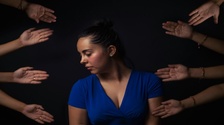Çeşitli İngilizce öğretmenleri arasından arama yapın...
tatsuki
This is my first post of the year. Hope all is well with you and your family. I came across an article online about the eyesight of children all over the world and would like to share it here.
Research shows eyesight of children in the world is deteriorating. According to BBC in U.K, the research team in China revealed the rate of near-sighted eyes of children across the world reached 36 percent. This symptom has appeared since the pandemic due to Covid-19. The team pointed out the cause is that the time kids spent indoor and watched displays has increased due to the protocol by the government. They also suspects that it's highly likely that girls have a higher rate of near-sighted eyes than boys because they have less time to play outside. On top of that, they warned the half of children in the world might have near-sighted eyes until 2050.
Their research shows 83% of children in Japan, 73% of one in Korea suffers from near-sighted eyes. On the other hand, in the case of U.K and U.S, it is only 15%. The reason why children in East South Asia region has high rate of near-sighted eyes is because education is one of the causes. In Singapore and Hong Kong, education starts when children turn 2 and it is said this takes a toll on them. On the other hand, children in Africa have 7 times lower near-sighted eyes because their education starts when they turn over 6.
I have near-sighted eyes too. I'm as blind as a bat with out contact lenses and glasses when I do something. So, these are must-have item for me. So, I really hope kids nowadays try to protect themselves from near-sighted eyes as soon as possible by decreasing time to watch displays and use smartphones.
12 Oca 2025 08:20
Düzeltmeler · 10
This is my first post of the year. I hope all is well with you and your family. Recently, I came across an article about children's eyesight worldwide, and I wanted to share it here.
Research shows that children's eyesight is deteriorating globally. According to the BBC in the U.K., a research team in China revealed that the global rate of nearsightedness in children has reached 36%. This issue has been linked to the Covid-19 pandemic, as government protocols increased the time children spent indoors using screens. The researchers also suspect that girls may be at a higher risk of developing nearsightedness than boys, as they tend to spend less time playing outdoors. They further warned that by 2050, half of the world’s children could be affected by nearsightedness.
The study highlighted that 83% of children in Japan and 73% in Korea are nearsighted, compared to only 15% in the U.K. and U.S. One major factor contributing to the high rates in East and Southeast Asia is education. In countries like Singapore and Hong Kong, formal education often begins as early as age two, which places additional strain on young eyes. In contrast, children in Africa experience far lower rates of nearsightedness—seven times lower—because formal schooling typically starts after age six.
I am nearsighted myself. Without contact lenses or glasses, I’m as blind as a bat, so these are essential items for me. I really hope children today can protect their eyesight by reducing screen time and being mindful of their habits with devices like smartphones.
Focus on: 1. Conciseness: Avoid repetition and streamline ideas. 2. Natural flow: Use transitions and idiomatic expressions where appropriate. 3. Grammar accuracy: Ensure subject-verb agreement and article usage.
12 Oca 2025 12:26
This is my first post of the year. Hope all is well with you and your family. I
came across an article online about children’s eyesight all over the world
and would like to share it here. Research shows eyesight of children in the
world is deteriorating. According to the BBC, a research team in China
revealed the rate of near-sighted children across the world had reached 36
percent, an increase since the COVID pandemic. The team claimed that the likely cause was children spending more time indoors watching TV and mobile phones
due to the COVID protocol by the government….
12 Oca 2025 10:51
This is my first post of the year. Hope all is well with you and your family. I
came across an article online about the eyesight of children all over the world
and would like to share it here. Research shows eyesight of children in the
world is deteriorating. According to BBC in U.K, the research team in China
revealed the rate of near-sighted eyes of children across the world reached 36
percent. This symptom has appeared since the pandemic due to Covid-19. The team
pointed out the cause is that the time kids spent indoor and watched displays
has increased due to the protocol by the government. They also suspects that
it's highly likely that girls have a higher rate of near-sighted eyes than boys
because they have less time to play outside. On top of that, they warned the
half of children in the world might have near-sighted eyes until 2050. Their
research shows 83% of children in Japan, 73% of one in Korea suffers from
near-sighted eyes. On the other hand, in the case of U.K and U.S, it is only
15%. The reason why children in East South Asia region has high rate of
near-sighted eyes is because education is one of the causes. In Singapore and
Hong Kong, education starts when children turn 2 and it is said this takes a
toll on them. On the other hand, children in Africa have 7 times lower
near-sighted eyes because their education starts when they turn over 6. I have
near-sighted eyes too. I'm as blind as a bat with out contact lenses and glasses
when I do something. So, these are must-have item for me. So, I really hope kids
nowadays try to protect themselves from near-sighted eyes as soon as possible by
decreasing time to watch displays and use smartphones.
12 Oca 2025 22:09
I am also near-sighted, and unfortunately am as blind as a bat without contact lenses or glasses. I really hope that children
nowadays will try to protect their eyes from as possible by
decreasing their time spent looking at screens and using smartphones.
12 Oca 2025 10:58
Additionally, the world might experience an increase in near-sighted people until 2050. The team’s
research showed 83% of children in Japan and 73% of Korea suffer from being
near-sighted. However, in the case of U.K and U.S, it is only
15%. The reason why children in East South Asia region may have higher rates of
near-sightedness is because of hours spent in education. In Singapore and
Hong Kong, education starts when children turn 2 and it is said this takes a
toll on them. Whereas children in Africa have 7 times less cases of
near-sightedness because they begin education at the age of 6….
12 Oca 2025 10:55
Daha hızlı mı ilerlemek istiyorsun?
Bu öğrenme topluluğuna katıl ve ücretsiz alıştırmaları dene!
tatsuki
Dil Becerileri
İngilizce, Japonca
Öğrenim Dili
İngilizce
Beğenebileceğin Makaleler

🎃 October Traditions: Halloween, Holidays, and Learning Portuguese
36 beğeni · 18 Yorumlar

The Curious World of Silent Letters in English
52 beğeni · 27 Yorumlar

5 Polite Ways to Say “No” at Work
43 beğeni · 13 Yorumlar
Daha fazla makale
